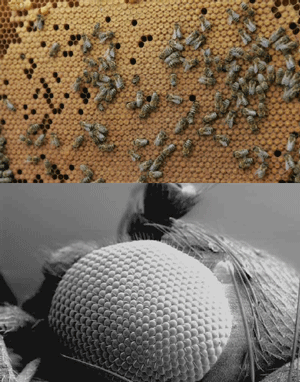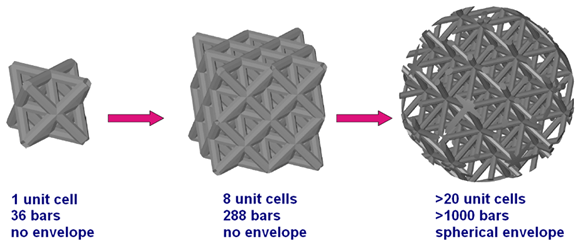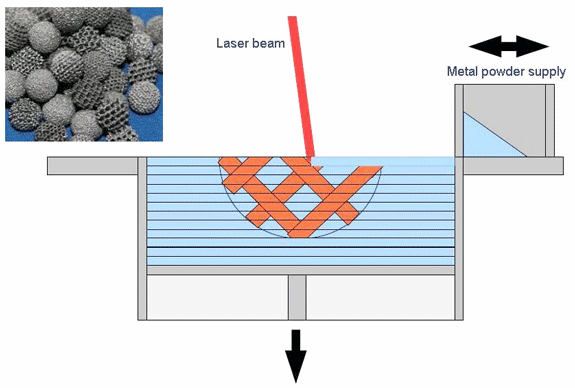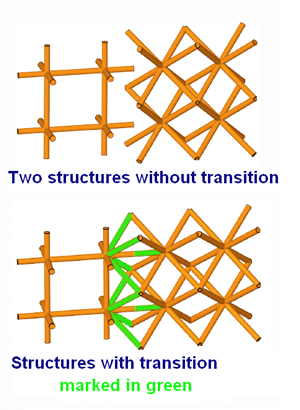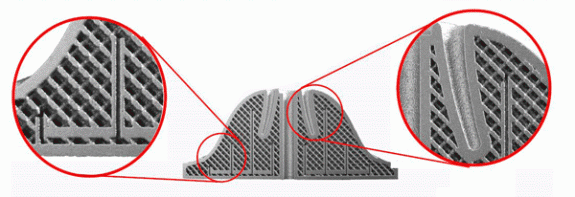2010 Hagen Symposium Reports: Designing complex structures using Selective Laser Sintering (SLS)
Inspiration from natural structures
Natural structures are often complex and based on a unit cell which is repeated many times. Fig. 1 shows two examples, honeycombs in a bee hive and the eye of an insect.
This construction principle has proven to be a very efficient method for light weight and high strength bodies, and it is very efficient with regards to raw materials and energy.
The construction plan for such a structure is contained in the unit cell and the outer shape of the body. It is not necessary to design each individual cell separately.
Application in component design
The transformation of this principle into a technical form is demonstrated in Fig.2. On the left is a unit cell which is made up of 36 individual bars. This unit cell can be generated by computer relatively easily. The repetition of this unit cell in three dimensions leads to the body in the middle.
Conventional CAD software would calculate each bar individually and need 8 times the computing time required for the unit cell. If however the unit cell is taken as the basis of the structure and repeated 8 times, the time for calculation is just a little more than the time required for the unit cell.
An outer shape is superimposed on the lattice of the structure. A sphere, for example, which includes the body of 8 unit cells, requires a structure of more than 20 unit cells corresponding to more than 1000 bars. The surface of the sphere is simply superimposed on the structure. For a computer this means that the time to calculate such a structure is relatively short.
The use of Selective Laser Sintering
These computer designed structures are transformed into real products by means of Selective Laser Sintering (SLS) as shown in Fig. 3. A laser beam is led over a powder bed in a certain pattern and the powder particles sinter at all points on the surface that are heated by the laser. Then the powder bed is lowered a little and a new layer of fresh powder is applied on top of it. With the next laser pattern the erection of the structure is continued, and so on. Layer by layer the most complex components can be made. Once the construction plan has been set up, it can be repeatedly manufactured.
FIT claims that the computer design software applied for these structures saves the construction plans in the form of a script which can be executed as often as required. Juggling with different scripts and functions is reported to be easy and efficient.
The software can even recognise neighbouring structures and automatically generate a predetermined transition (Fig. 4). Forces can thus be transferred between different structures without losses.
Applications
Applications for this technology can be found in technical medicine. Implants made from titanium are used as replacements for injured bone structures (Fig. 5). The material is compatible with the tissue of the body and the irregular shape of the surface supports the regeneration and growth of the bone. Implants can be individually designed to the patient’s injury and manufactured rapidly as individual items or repeated many times. The item on the right of Fig. 5 is an implant for the skull.
This technology is also suitable for producing all kinds of heat exchangers. An example is shown in Fig. 6. The cooling agent is led to the surface where it is needed through capillary channels. The outer wall thickness is constant for uniform heat transfer. The inner structure guarantees the stability of the component and ensures a uniform gas distribution.
Whether individual design, medium or high volume production, Selective Laser Sintering supported by an intelligent software is a powerful tool for manufacturing complex structures integrated in a single component that were previously unthinkable.
News | Articles | Market reviews | Search directory | Subscribe to e-newsletter



